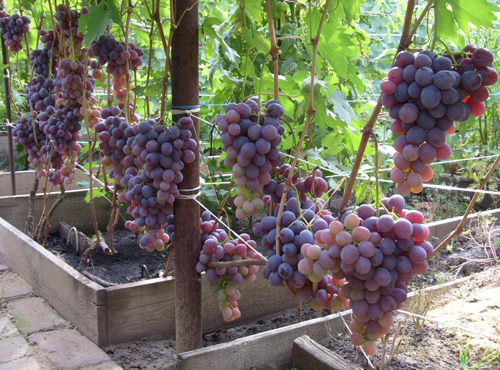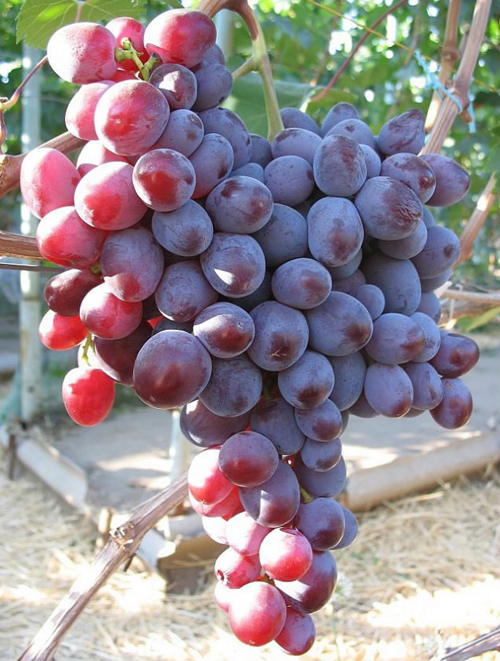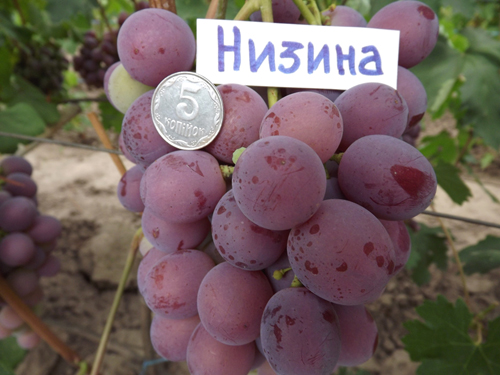Nizina grape variety
Without exaggeration, the table grape variety Nizina can be called a pioneer of modern domestic national selection. Its appearance at the end of the past millennium has become a kind of guiding star for a whole galaxy of folk breeders, inspired by the successful experience of amateur crossbreeding of grapes and the amazing result obtained. The author of the novelty was Viktor Krainov, a legendary personality among winegrowers, who then created several dozen more wonderful hybrid forms, many of which officially became varieties.

The history of the appearance of the Lowland, Viktor Nikolaevich, subsequently described in detail in an interview. According to him, he began to be engaged in viticulture in 1953 at the age of fifteen on the site of his father. In 1986, he acquired land on the banks of the Tuzla River in the Rostov region, where he already laid his own vineyard, not even dreaming of breeding work yet. The famous scientist, leading breeder of the Novocherkassk Scientific Research Institute of Viticulture and Winemaking Ivan Kostrikin pushed him to this direction of activity. He invited Viktor Krainov and several other winegrowers to conduct simple experiments on crossing grapes on their plots, and to facilitate the task, he recommended using varieties with a functionally female type of flowering as a mother form, which excluded the possibility of self-pollination. The most promising contender in this regard was the brainchild of Kostrikin himself - a large-fruited and rather unpretentious, at that time still a hybrid, Mascot.
The beginning "Michurinist" Krainov for his first experiments in 1995-1996 chose three parental pairs: Talisman x Radiant kishmish, Talisman x Autumn Black and Talisman x Tomaysky. All three paternal varieties were from Moldova, where at different times they were obtained by specialists from the local research institute of viticulture and winemaking "Vierul". The choice turned out to be surprisingly successful, only one crossing of the Talisman with Radiant Kishmish later made it possible to select several grape seedlings with magnificent bunches in appearance and taste. However, the offspring of another pair, Talisman and Tomaysky, were the first in 1998 to bear fruit, and it was among them that Viktor Nikolaevich singled out the wonderful Nizina.
The new large-fruited, very tasty and relatively unpretentious hybrid in cultivation gradually gained very wide popularity among amateur winegrowers, and in 2015 it successfully completed the state variety testing, and was officially recommended for cultivation in garden plots throughout the country.

Agrobiological characteristics of the variety
The growth of lowland bushes is strong. The crown of a young shoot is white-green with a pink tip. The grape leaf is wavy, medium-sized, rounded, consists of five strongly split blades. The surface of the leaf blade is smooth, on the reverse side there is a cobweb pubescence of medium density. The upper notches of the leaf are deep, closed with an oval opening, less often open, lyre-shaped with a rounded bottom. Lower notches of shallower depth, V-shaped, or almost absent. The petiole notch is open, vaulted with a flat or pointed bottom. The petiole is long, burgundy in color. The denticles are large, triangular, elongated in length, have a narrow base, curved edges, and slightly rounded apices. The color of the foliage is green; in the fall, redness begins from the edge. The flower is bisexual, pollinated well, as a rule, there are no defects in bunches like pea berries. Ripening of annual shoots is good.
The clusters are cylindro-conical, moderately dense, grow very significant in size. Their average weight is 600-900 grams, the most outstanding - up to one and a half to two kilograms. The comb is long, thin and graceful, but strong at the same time.The berries of the variety are large and very large, aligned, oval in shape, about 30 × 22 mm in size and an average weight of 10-12 grams. The color of the Lowlands grapes is red-violet, but its intensity can vary considerably. A characteristic feature of this hybrid form is the early coloration of the crop, which often occurs two weeks before the onset of removable ripeness. The pulp of the berries is dense, fleshy, sweet and sour to taste, without specific varietal tastes and aromas. At the time of readiness for consumption, grapes contain 17-18% sugars and 8-9 grams / liter of titratable acids. The existing acidity disappears with late harvesting of the bunches. The peel is of medium thickness, the outside is covered with a gray protective waxy coating, it is easy to chew when eating. There are 2-3 seeds in a berry, which is not a significant gastronomic disadvantage for large grapes. Taste qualities are consistently high. The tasting score obtained at the stage of the state variety testing is 7.9 points.
Basically, the crop is used for fresh consumption, but quite often it is successfully used in home canning for making jams and compotes, elegant in color. Large bunches and berries of the Niziny have an excellent presentation, are in demand among buyers in the market, however, the average ripening period somewhat reduces the profitability of its cultivation by farmers in comparison with early varieties, due to the seasonal decline in grape prices in September. The bunches tolerate long-distance transportation very well, and in cool, dry rooms or refrigerated chambers, the crop can be stored for up to three months.

The growing season from the beginning of budding to the onset of removable maturity lasts 125-130 days. In the Rostov region, the first collection can be started in late August and early September. At the same time, due to the not the highest amount of active temperatures required for the variety (2600-2700 ° C), it can be cultivated in the regions of the central Black Earth Region, throughout the territory of Ukraine and the south of Belarus. In regions that are not traditional for viticulture, it will naturally be necessary to insulate the aboveground part of the bushes for the winter, because the frost resistance of the hybrid (-23 ° C) does not allow cultivating it in uncovered culture in cold climates.
The lowland yield is very high. An average of 174 centners of production are obtained per hectare of plantations. At the same time, mature, well-developed and well-groomed bushes, showing no signs of overload, can produce up to 20 kg of good quality grapes. Such a high productivity is due to the large fruit size and good fertility rates characteristic of the variety. In particular, the proportion of fruiting shoots in plants reaches 80%, and the average number of clusters on them is 1.1-1.4. This requires protecting the Lowlands from overload by rationing the bushes with crops. With particular care, it is important to do this in the relatively northern regions of hybrid cultivation, where excessive stress, causing an extension of the growing season, can lead to the need to harvest unripe grapes, and the plants themselves cannot be fully prepared for winter.
Well, in the south, where climatic conditions allow ripe bunches to hang longer, you must definitely use this opportunity. A fully ripe crop significantly improves its palatability by reducing acidity and accumulating additional sugar. At the same time, you should not worry about possible cracking - the Lowland does not show such a tendency. But with wasps, you need to be careful, many growers complain about the active interest of insects in the variety. To combat annoying pests, special traps are suitable, but it is better to use individual bags to protect the bunches, which will protect the bunches from damage and will not harm the wasps themselves.
Agrotechnical features
From an economic point of view, the Lowland should be attributed to the "middle peasants": grapes do not have outstanding resistance to frost and diseases, however, they do not show critical gaps in agrobiology.
Planting is carried out both by cuttings on their own roots and by grafted seedlings.Both options are easy to implement due to easy rooting and good affinity of the variety with rootstocks. The best rootstock forms for it are Berlandieri x Riparia CO4 and Berlandieri x Riparia Kober 5BB. The choice of the propagation method depends on the contamination of the soil by the root phylloxera. A self-rooted version is appropriate in areas free from this pest, well, but otherwise the grafted culture becomes the only possible one.
The lowland develops rapidly and enters the fruiting phase, and therefore, already in the second year, it is necessary to attend to the formation of the skeleton of the future grape bush and fundamentally determine the scheme of its management. Before that, it is necessary to sensibly assess the existing climatic conditions, and first of all those temperature minimums that the winter period presents in a particular area. If the vineyard is located in the south, where critical temperatures of -23 ° C are unlikely, then the best solution would be to form bushes on a high stem, or even in a gazebo or arched culture. Vigorous bushes, having accumulated a stock of perennial wood, will be able to accumulate significant volumes of plastic substances, which will become the basis for excellent in terms of quantity and quality of crops. In the case when the nature of winter does not allow cultivating the variety in an uncovered form, it is required to choose standard formations that allow removing the vine from the trellis in autumn without damage and burying it in the ground, or insulating it with special means. As a heater, improvised organic materials can be used - straw, wood shavings, a needle holder, spruce branches, reed mats and even a dry fallen leaf. The main thing is to make a waterproofing layer on top of the insulating layer from a film, roofing material or wooden shields, so that the grape vine does not get wet and the eyes do not blow out on it.
The load on the fruiting Plants of the Lowlands should be fairly standard in nature, but nevertheless carried out with all the quality. During spring pruning, depending on the size of the bush, 30-40 buds are left, shortening the fruit arrows by an average of 5-9 eyes. After the beginning of the growing season, sterile and weak shoots are removed, so that ultimately about 22-26 fruitful vines remain on the plant, on which inflorescences are thinned out before flowering, one per shoot being preserved. During the growth of berries, the load can be finally adjusted by pinching, if necessary, the lower third of the largest brushes.
Protection against grape diseases should be carried out taking into account the specificity of the variety's resistance to each of them. So, Lowland is tolerant to mildew (resistance at 3.0 points), rarely affected by gray rot, but powdery mildew (powdery mildew) can be very harmful. In this regard, one-time treatments will be enough against mildew, it is necessary to fight against mildew according to standard protection schemes, and you can try to cope with gray rot with preventive measures - ensuring good ventilation of the bunches by removing leaves around them.
The timing of the harvest in the Lowlands should be determined by the taste ratings of the berries and the harmony of their sugar and acid content. You should not rush to harvest, focusing only on the intensity of the staining of the grapes - for this variety, this sign is very deceptive. From a gastronomic point of view, the bunches become the best with some overexposure on the bushes, if, of course, the weather permits, and the brushes themselves are reliably protected from pests.








